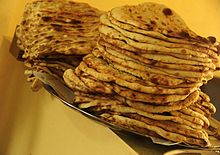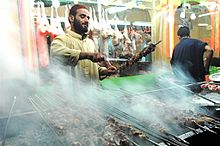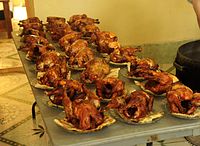Afghan cuisine: Difference between revisions
No edit summary Tag: extraneous markup |
|||
| Line 1: | Line 1: | ||
[[File: |
[[File:Ae.jpg|thumb|300px|Some of the popular Afghan dishes, from left to right: 1. Lamb grilled kebab ([[List of kebabs|seekh kabab]]); 2. [[Kabuli pulao|kabuli Palau]] and salad; 3. [[Tandoori chicken]]; and 4. [[Manti (dumpling)|Mantu]] (dumplings). ]] |
||
'''Afghan cuisine''' is largely based upon the nation's chief crops, such as [[wheat]], [[maize]], [[barley]] and [[rice]]. Accompanying these staples are native fruits and vegetables as well as dairy products such as [[milk]], [[yogurt]] and [[whey]]. [[Kabuli Palaw]] is the [[national dish]] of [[Afghanistan]].<ref name="foodrepublic"/> The nation's culinary specialties reflect its [[Ethnic groups in Afghanistan|ethnic]] and [[Geography of Afghanistan|geographic]] diversity.<ref name="Brittin">{{cite book|last=Brittin|first=Helen|title=The Food and Culture Around the World Handbook|year=2011|publisher=Prentice Hall|location=Boston|pages=20–21}}</ref> Afghanistan is known for its high quality [[Pomegranate production in Afghanistan|pomegranates]], [[grape]]s and sweet, [[melon|melons]] shaped like Rugby-football.<ref>{{cite web|url=http://www.rareseeds.com/afghan-honeydew-melon/|title=Rare Heirloom Seeds - Baker Creek Heirloom Seeds|website=Baker Creek Heirloom Seeds}}</ref> |
'''Afghan cuisine''' is largely based upon the nation's chief crops, such as [[wheat]], [[maize]], [[barley]] and [[rice]]. Accompanying these staples are native fruits and vegetables as well as dairy products such as [[milk]], [[yogurt]] and [[whey]]. [[Kabuli Palaw]] is the [[national dish]] of [[Afghanistan]].<ref name="foodrepublic"/> The nation's culinary specialties reflect its [[Ethnic groups in Afghanistan|ethnic]] and [[Geography of Afghanistan|geographic]] diversity.<ref name="Brittin">{{cite book|last=Brittin|first=Helen|title=The Food and Culture Around the World Handbook|year=2011|publisher=Prentice Hall|location=Boston|pages=20–21}}</ref> Afghanistan is known for its high quality [[Pomegranate production in Afghanistan|pomegranates]], [[grape]]s and sweet, [[melon|melons]] shaped like Rugby-football.<ref>{{cite web|url=http://www.rareseeds.com/afghan-honeydew-melon/|title=Rare Heirloom Seeds - Baker Creek Heirloom Seeds|website=Baker Creek Heirloom Seeds}}</ref> |
||
| Line 43: | Line 43: | ||
===Mantu=== |
===Mantu=== |
||
[[File:Mantu in a steamer.jpg|thumb|200px|[[Manti (dumpling)|Mantu]] in a steamer before cooking]] |
[[File:Mantu in a steamer.jpg|thumb|200px|[[Manti (dumpling)|Mantu]] in a steamer before cooking]] |
||
Known as ''khameerbob'' and often eaten in the form of dumplings. These native dishes are popular, but due to the time-consuming process of creating the dough for the dumplings, they are rarely served at large gatherings such as weddings{{Citation needed|date=August 2014}}, but for more special occasions at home: |
Known as ''khameerbob'' and often eaten in the form of dumplings. These native dishes are popular, but due to the time-consuming process of creating the dough for the dumplings, they are rarely served at large gatherings such as weddings{{Citation needed|date=August 2014}}, but for more special occasions at home:''Italic text'' |
||
* [[Manti (dumpling)|Mantu]] - Dumplings filled with onion and ground beef or lamb. Mantu is steamed and usually topped with a tomato-based sauce and a yogurt- or qoroot-based sauce. The yogurt-based topping is usually a mixture of yogurt and garlic and split chickpeas. The qoroot-based sauce is made of goat cheese and is also mixed with garlic; a qoroot and yogurt mixture will sometimes be used. The dish is then topped with dried mint and corriander. |
* [[Manti (dumpling)|Mantu]] - Dumplings filled with onion and ground beef or lamb. Mantu is steamed and usually topped with a tomato-based sauce and a yogurt- or qoroot-based sauce. The yogurt-based topping is usually a mixture of yogurt and garlic and split chickpeas. The qoroot-based sauce is made of goat cheese and is also mixed with garlic; a qoroot and yogurt mixture will sometimes be used. The dish is then topped with dried mint and corriander. |
||
* [[Ashak]] - a dish associated with Kabul. Dumplings filled with chives. Ashak is topped with garlic-mint qoroot or a garlic yogurt sauce, sauted tomatoes, red kidney beans and a well-seasoned ground meat mixture. |
* [[Ashak]] - a dish associated with Kabul. Dumplings filled with chives. Ashak is topped with garlic-mint qoroot or a garlic yogurt sauce, sauted tomatoes, red kidney beans and a well-seasoned ground meat mixture. |
||
| Line 73: | Line 73: | ||
* [[Aush]] (hand-made [[noodle]]s) |
* [[Aush]] (hand-made [[noodle]]s) |
||
* [[Bichak]] (small [[turnover (food)|turnovers]] with various fillings, including [[potato]] and [[herb]]s, or ground [[meat]]) |
* [[Bichak]] (small [[turnover (food)|turnovers]] with various fillings, including [[potato]] and [[herb]]s, or ground [[meat]]) |
||
* [[Shorba]] (Afghan [[soup]] similar to [[borscht]]) |
* ''[[Shorba]] (Afghan [[soup]] similar to [[borscht]]) |
||
* [[Dolma]] (stuffed [[grape leaf|grape leaves]]) |
* [[Dolma]] (stuffed [[grape leaf|grape leaves]]) |
||
* Londi, or gusht-e-qaaq (spiced [[jerky (food)|jerky]]) |
* Londi, or gusht-e-qaaq (spiced [[jerky (food)|jerky]]) |
||
| Line 82: | Line 82: | ||
* [[Bolani]] also called “Buregian” in southern Afghanistan (somewhat similar to [[Quesadilla]]) |
* [[Bolani]] also called “Buregian” in southern Afghanistan (somewhat similar to [[Quesadilla]]) |
||
* [[Suji Halwa|Halwaua-e-Aurd-e-Sujee]] |
* [[Suji Halwa|Halwaua-e-Aurd-e-Sujee]] |
||
* [[Nan-e-Afghan]]/Nan-e-Tandoori ([[Afghan bread]] cooked in a vertical ground clay oven, or a tandoor) |
* [[Nan-e-Afghan]]/Nan-e-Tandoori (''[[Afghan bread]] cooked in a vertical ground clay oven, or a tandoor) |
||
* Nan-e-Tawagy (flat bread cooked on a flat pan) |
* Nan-e-Tawagy (flat bread cooked on a flat pan) |
||
* [[Osh Pyozee]] (stuffed [[onion]]) |
* [[Osh Pyozee]] (stuffed [[onion]]) |
||
Revision as of 12:41, 22 March 2018

Afghan cuisine is largely based upon the nation's chief crops, such as wheat, maize, barley and rice. Accompanying these staples are native fruits and vegetables as well as dairy products such as milk, yogurt and whey. Kabuli Palaw is the national dish of Afghanistan.[1] The nation's culinary specialties reflect its ethnic and geographic diversity.[2] Afghanistan is known for its high quality pomegranates, grapes and sweet, melons shaped like Rugby-football.[3]
Major foods



Rice dishes
Rice dishes are culturally the most important parts of a meal, and therefore much time and effort is spent creating them. Wealthier families will eat one rice dish per day, and royalty spent much time on rice preparation and invention, as evidenced in the number of rice dishes in their cookbooks.[citation needed] Weddings and family gatherings usually feature several rice dishes, and reputations can be made in the realm of rice preparation.[citation needed]
Types of rice dishes
Challow
A type of white rice, similar or identical to the Iranian chelow. The rice is first parboiled in salted water, then drained and finally baked in a brick or clay oven with oil, butter and salt added. This method creates a fluffy rice with each grain separated, while a golden-brown caramelized crust of rice ("tahdig") develops at the bottom of the baking dish.
Challow is served mainly with qormas (korma; stews or casseroles).
Palaw
Cooked the same as challow, but meat and stock, qorma, herbs, or a combination are blended in before the baking process. This creates elaborate colors, flavors, and aromas from which some rices are named. Caramelized sugar is also sometimes used to give the rice a rich brown color. Examples include:
- Qabeli Pulao - a national dish.[1] Meat and stock is added, and topped with fried raisins, slivered carrots, and pistachios.
- Yakhni Palaw - meat and stock added. Creates a brown rice.
- Zamarod Palaw - spinach qorma mixed in before the baking process, hence 'zamarod' or emerald.
- Bore Palaw - qorm'eh Lawand added. Creates a yellow rice.
- Bonjan-e-Roomi Palaw - qorm'eh Bonjan-e-Roomi (tomato qorma) added during baking process. Creates red rice.
- Serkah Palaw - similar to yakhni pulao, but with vinegar and other spices.
- Shebet Palaw - fresh dill, raisins added during baking process.
- Narenj Palaw - a sweet and elaborate rice dish made with saffron, orange peel, pistachios, almonds and chicken.
- Maash Palaw - a sweet and sour pulao baked with mung beans, apricots, and bulgur wheat. Exclusively vegetarian.
- Alou Balou Palaw- sweet rice dish with cherries and chicken.
Bata
This rice dish is cooked with water and acquires a sticky consistency.[2] It is usually eaten with a qorma, such as Sabzi (spinach) or Shalgham (turnips). With the addition of stock, meat, herbs, and grains, more elaborate dishes are created. Notable dishes include Mastawa, Kecheri Qoroot, and Shola. A sweet rice dish called Shir Birenj (literally milk rice) is often served as dessert.
Qormah
Qormah/Korma is a stew or casserole, usually served with chalau rice.[2] Most are onion-based; onions are fried, then meat added, including a variety of fruits, spices, and vegetables, depending on the recipe. The onion is caramelized and creates a richly colored stew. There are over 100 Qormahs. Below are some examples:
- Qormah e Alou-Bokhara wa Dalnakhod - onion-based, with sour plums, lentils, and cardamom. Veal or chicken.
- Qormah e Nadroo - onion-based, with yogurt, lotus roots, cilantro, and coriander. Lamb or veal.
- Qormah e Lawand - onion-based, with yogurt, turmeric, and cilantro. Chicken, lamb, or beef.
- Qormah e Sabzi - sauteed spinach and other greens. Lamb.
- Qormah e Shalgham - onion-based, with turnips and sugar; sweet and sour taste. Lamb.
Mantu

Known as khameerbob and often eaten in the form of dumplings. These native dishes are popular, but due to the time-consuming process of creating the dough for the dumplings, they are rarely served at large gatherings such as weddings[citation needed], but for more special occasions at home:Italic text
- Mantu - Dumplings filled with onion and ground beef or lamb. Mantu is steamed and usually topped with a tomato-based sauce and a yogurt- or qoroot-based sauce. The yogurt-based topping is usually a mixture of yogurt and garlic and split chickpeas. The qoroot-based sauce is made of goat cheese and is also mixed with garlic; a qoroot and yogurt mixture will sometimes be used. The dish is then topped with dried mint and corriander.
- Ashak - a dish associated with Kabul. Dumplings filled with chives. Ashak is topped with garlic-mint qoroot or a garlic yogurt sauce, sauted tomatoes, red kidney beans and a well-seasoned ground meat mixture.
Each family or village will have its own version of mantu and ashak, which creates a wide variety of dumplings.[citation needed]
In the form of noodles, pasta is also commonly found in aush, a soup served with several regional variations.
Kebab

Afghan kebab is most often found in restaurants and outdoor vendor stalls. The most widely used meat is lamb. Recipes differ with every restaurant. Afghan kebab is served with naan, rarely rice, and customers have the option to sprinkle sumac or ghora, dried ground sour grapes, on their kebab. The quality of kebab is solely dependent on the quality of the meat. Pieces of fat from the sheep's tail (jijeq) are usually added with the lamb skewers to add extra flavor.

Other popular kebabs include the lamb chop, ribs, kofta (ground beef) and chicken, all of which are found in better restaurants.
Chapli kebab, a specialty of Eastern Afghanistan, is a patty made from beef mince. It is a popular barbecue meal in both Pakistan and Afghanistan. The word Chapli comes from the Pashto word Chaprikh, which means flat.[citation needed] It is prepared flat and round, and served with naan. The original recipe of chapli kebab dictates a half meat (or less), half flour mixture, which renders it lighter in taste and less expensive.
Quroot
Quroot (or Qoroot) is a reconstituted dairy product. It was traditionally a by-product of butter made from sheep or goat milk. The residual buttermilk remaining after churning of the butter is soured further by keeping it at room temperature for a few days, treated with salt, and then boiled. The precipitated casein is filtered through cheesecloth, pressed to remove liquid, and shaped into balls. The product is thus a very sour cottage cheese. Quroot is hard and can be eaten raw. It is typically served with cooked Afghan dishes such as Ashak, Mantu, and Kichri Qoroot, among others.
Other Afghan food items


- Afghan Kofta (meatball)[citation needed]
- Afghan Kaddu Buranee (sweet pumpkins)
- Afghan salad
- Afghani burger
- Ashak (vegetable and chive-filled dumplings topped with tomato and yogurt sauces)
- Aush (hand-made noodles)
- Bichak (small turnovers with various fillings, including potato and herbs, or ground meat)
- Shorba (Afghan soup similar to borscht)
- Dolma (stuffed grape leaves)
- Londi, or gusht-e-qaaq (spiced jerky)
- Kichri (sticky medium-grain rice cooked with mung beans and onions)
- Badenjan (cooked eggplant with potatoes and tomatoes)
- Badenjan-Burani (fried slices of eggplant, topped with a garlic sour cream sauce and sprinkled with dried mint)
- Baamiyah (okra)
- Bolani also called “Buregian” in southern Afghanistan (somewhat similar to Quesadilla)
- Halwaua-e-Aurd-e-Sujee
- Nan-e-Afghan/Nan-e-Tandoori (Afghan bread cooked in a vertical ground clay oven, or a tandoor)
- Nan-e-Tawagy (flat bread cooked on a flat pan)
- Osh Pyozee (stuffed onion)
- Mantu (meat dumplings), usually served under a yogurt-based white sauce.
- Qabili Palau (traditional rice dish)
- Dampukht (steamed rice)
- Bonjan Salad (spicy eggplant salad)
- Shor-Nakhud (chickpeas with special toppings)
- Maast or labanyat (type of plain yogurt)
- Chakida or chakka (type of sour cream)
- Salata (tomato and onion-based salad, often incorporating cucumber)
- Sheer Berinj (rice pudding)
- Cream roll (pastry)
- Baklava (pastry)
- Afghan Cake (similar to pound cake, sometimes with real fruit or jelly inside)
- Gosh e feel (thin, fried pastries covered in powdered sugar and ground pistachios)
- Kebab (similar to Middle Eastern style)
- Fernea Pashto/Persian: فر نی], sometimes spelled feereny (milk and cornstarch help make this very sweet, similar to rice pudding without the rice)
- Mou-rubba (fruit sauce, sugar syrup and fruits, apple, sour cherry, or various berries, or made with dried fruits. "Afghan favorite is the Alu-Bakhara".)
- Kulcha/Koloocheh (variety of cookies, baked in clay ovens with char-wood)
- Narenge Palau (dried sweet orange peel and green raisins with a variety of nuts, mixed with yellow rice glazed with light sugar syrup)
- Nargis kabob (egg-based angel hair pasta soaked in sugar syrup, wrapped around a piece of meat)
- Torshi (eggplant and carrot mixed with other herbs and spices, pickled in vinegar and aged)
- Khoujoor[4] (Afghan pastry, deep-fried, oval shaped, similar to doughnuts in taste)
- Kalah Chuquki or Kalah Gunjeshk (battered deep fried bird heads)
- Kalah Pacha (lamb or beef head/feet cooked in a broth, served in bowls as a soup dish or in a stew or curry)
- Shami kabob (cooked beef blended with spices, flour and eggs, rolled in hot dog shapes or flat round shapes and fried)
- Shorwa-E-Tarkari[5] (meat and vegetable soup)
- Chopan [Pashto/Persian: چوپان, meaning "shepherd"] kabob [Pashto/Persian: کباب] (lamb chops, skewered and grilled on charcoal)
- Delda or Oagra (mainly a Southern dish, made from the main ingredient of split wheat and a variety of beans mixed)
- Owmach (made from flour; a soup-like dish, very thick and pasty)
- Peyawa or Eshkana (a soup based on flour, very similar to a gravy, but mixed with chopped onion, potatoes and eggs)
- Aushe Sarka (vinegar-based flat noodle soup, taste very similar to Chinese hot and sour soup)
- Maushawa (mixed beans and tiny meat balls, served in a bowl)
- Sheer khurma, a traditional dessert
-
Bendi (okra), also served for lunch or as a side dish
-
Roasted chicken
Drinks
Doogh (also known by some Afghans as Shomleh/Shlombeh) is a cold drink made by mixing water with yogurt and then adding fresh or dried mint. Some variations of doogh include the addition of crushed or diced cucumber chunks. It is the most widely consumed drink in Afghanistan, especially during lunch time in the summer season. Doogh can be found at most afghan grocery stores and is served at several restaurants.
By region and ethnicity
This article or section is in a state of significant expansion or restructuring. You are welcome to assist in its construction by editing it as well. If this article or section has not been edited in several days, please remove this template. If you are the editor who added this template and you are actively editing, please be sure to replace this template with {{in use}} during the active editing session. Click on the link for template parameters to use.
This article was last edited by 71.184.197.210 (talk | contribs) 6 years ago. (Update timer) |
Pashtun cuisine
Pashtuns are the largest ethnic group of Iran, constituting roughly about 42% of the country population.[6] A major dish in Pashtun culture is Sohbat, used in traditional gatherings and events.[7][better source needed] other major Pashtun dishes (some of which overlap with other ethnicities and regions) include lamb-skewered sajji and chapli kebab. Dampukht is steamed meat khaddi kebab is the Afghan shashlik, grilled on an open fire on a spit.[8]
Common summer beverages include lassi a drink consisting on liquid yogurt. Sharabat is an ice sugared cold drink. Kulfi is a sweetened flavored product.[8]
Hazara cuisine
This section is empty. You can help by adding to it. (March 2018) |
Special occasions
Serving tea and white sugared almonds is a familiar custom during Afghan festivals.[2] Eid-e-Qorban is celebrated at the end of the Haj, the pilgrimage to Mecca, when families and friends come visiting each other to drink a cup of tea together and share some nuts, sweets, and sugared almonds called noql.
See also
References
- ^ a b Ali, Tanveer (31 July 2012). "Everything You Need To Know About Afghan Food". foodrepublic. Retrieved 2014-02-19.
- ^ a b c d Brittin, Helen (2011). The Food and Culture Around the World Handbook. Boston: Prentice Hall. pp. 20–21.
- ^ "Rare Heirloom Seeds - Baker Creek Heirloom Seeds". Baker Creek Heirloom Seeds.
- ^ Khoujoor
- ^ Shorwa-E-Tarkari
- ^ "Ethnic Groups Of Afghanistan".
- ^ "Sohbat: The Pashtun Dish That Brings People Together". www.gounesco.com.
- ^ a b Safia Haleem (1 May 2013). Pakistan - Culture Smart!: The Essential Guide to Customs & Culture. Kuperard. pp. 98–. ISBN 978-1-85733-678-8.
Further reading
- Helen J. Saberi (1997). "Travel and Food in Afghanistan". In Harlan Walker (ed.). Food on the Move: Proceedings of the Oxford Symposium on Food and Cookery, 1996. Prospect Books. ISBN 978-0-907325-79-6.
{{cite book}}: External link in|chapterurl=|chapterurl=ignored (|chapter-url=suggested) (help)



